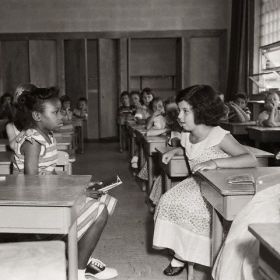Racial Gaps
On average, black students who graduate from high school are equipped with the skills the average white student mastered by the eighth grade, according to federal tests.
Blah blah blah . . .

A few months ago, the president of the University of Michigan stood on the steps of the Supreme Court after winning an affirmative action case and said what a wonderful, wonderful thing it is that in America, black students can still be held to a lower set of standards than white students.
And a lot of people agree with that. I don’t, but a lot of people do.
So — because kids will perform to the standards and expectations that are set for them — this academic skills gap is what we’re going to end up with. There’s no reason to sit around scratching our noggins over what’s causing it, or how to fix it.
Lack of Funding
Though more money doesn’t guarantee a better education, poor students suffer when per-child spending on them falls well below the national average. Typically, that means they won’t get the extra resources they need, such as reading tutors and high-quality preschools. Last year, schools spent an average $8,260 per student, excluding school construction. By contrast, Albuquerque spent only $5,399 per student. A district in Dillon, S.C., part of a lawsuit by rural schools that claims the state denies the schools adequate funding, spent $6,332 per student.
First of all, even $5,000 per student seems like a lot of money to me.

Let’s do the math: $5,000 times, let’s say, 30 students in a class is $150,000. Subtract out the teacher’s salary and the price of some chalk and you should still have a lot of money left over.
So schools are not being run in a cost-effective manner.
But that is not an easy problem to solve, so let’s frame the problem a different way . . .
I live in Irvine, CA. The school district is ranked in the 98th percentile nationally, while spending only $4,915 per student, $3,345 below the national average.
We also have large class sizes. My son’s 5th grade class has 34 students.
The difference between Irvine, CA, and Dillon, S.C., is that Irvine parents don’t stand around pissing their pants and suing people. They read to their kids, they help the kids with homework, they volunteer in the classroom . . .
CAT/6 testing starts next week. If you go to a local bookstore to buy a CAT/6 prep book, you’ll find that they sold out weeks ago.
My kid’s school also asks parents to kick in an extra $200 a year to make up for funding shortfalls.
Your kid’s education isn’t worth a little extra time and money to you? Then please shut your piehole . . .
